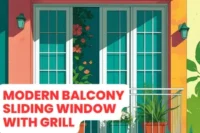Not All Plastics Are Equal, See How uPVC Is Made
Published: 15 Jun 25
Back in the 1930s, scientists discovered a new type of plastic—PVC. But it was not until the 1960s that uPVC came into play. So, how is uPVC made today? It all starts with vinyl chloride, a chemical that’s turned into a rigid plastic using polymerization. The result? A strong, weatherproof material without the softeners used in regular PVC. Over time, uPVC became the go-to choice for window frames and plumbing because of its strength and low maintenance. Knowing how uPVC is made gives us a glimpse into how far building materials have come, and how smart design shapes our homes.
Why uPVC Is Great for Homes
uPVC stands for unplasticized polyvinyl chloride. It is a hard, durable plastic used in many parts of the home, especially for windows, doors, and plumbing. What makes uPVC special is that it doesn’t have any added softeners, so it stays firm and strong for years. Homeowners love it because it doesn’t rust, rot, or need much service. It can handle rain, heat, and dust—perfect for all kinds of weather. Also, it helps keep your home quiet and energy efficient.
The History of uPVC
PVC, or polyvinyl chloride, was first discovered back in the 1930s by scientists exploring new types of plastics. It was flexible and useful, but not strong enough for certain building needs. That’s when uPVC came along in the 1960s. The “u” stands for “unplasticized,” meaning it doesn’t have added softeners. This made the material much tougher and ideal for homes. Over time, uPVC gained popularity for windows, doors, and plumbing because it could handle harsh weather, didn’t rust or rot, and lasted for years with little maintenance.
Step-by-Step: How uPVC Is Made
Ever wondered how the strong, white window frames in your home are made? Let’s break down the process of how uPVC is created—step by step—in a way that’s easy to understand.
Step 1: Making Vinyl Chloride
It all begins with a chemical called vinyl chloride. This is the base material. Factories create it by combining natural gas and salt through a series of chemical reactions.
Step 2: Polymerization – Making It Solid
The vinyl chloride is then put through a process called polymerization. This turns the liquid into a solid plastic. Think of it like making jelly—start with liquid, add the right process, and it sets into shape.
Step 3: No Softeners, Just Strength
Unlike regular PVC, uPVC doesn’t contain plasticizers (softening agents). This keeps it rigid, strong, and perfect for building things like windows, doors, and pipes.
Step 4: Shaping, Cooling, and Finishing
The solid uPVC is melted and pushed into molds to make long profiles—shapes used for windows or pipes. After molding, it’s cooled, cut to size, and made ready for use in your home.
Why This Process Matters for Your Home
Knowing how uPVC is made helps you understand why it’s such a smart choice for your home. Because of its solid build and no added softeners, uPVC offers better insulation, keeping your house cooler in summer and warmer in winter. Its strong, weatherproof surface stands up to rain, heat, and dust without cracking or fading. That means fewer repairs and less stress over time. Plus, uPVC is non-toxic and safe for families, making it a worry-free option for windows, doors, and pipes in any modern home.
Where You Will Find uPVC Around the House
uPVC is not just used in one place, it’s all around your home, quietly doing its job. common areas where you will spot it working hard for you every day.
uPVC Windows and Doors : These help keep your home peaceful by blocking outside noise. They also trap cool air inside during summer and warm air during winter, which helps save on energy bills.
Pipes and Plumbing : uPVC is often used in kitchen and bathroom pipes because it doesn’t rust or leak easily. It handles water well and lasts longer than many metal pipes.
Outdoor Uses : You will find uPVC in garden piping, rainwater drains, and wall cladding. It stands up to sun, rain, and wind without fading, cracking, or needing repainting.
How to Spot uPVC : Look for smooth, firm, white surfaces that feel solid and clean. Most window frames and drainage pipes made of uPVC have this sleek, bright look.
Conclusion
Understanding how uPVC is made gives you a real advantage as a homeowner. It helps you make smarter choices when buying windows, doors, or plumbing materials. You will know what to look for and why quality matters. uPVC is not just another building material—it’s a modern solution that makes homes stronger, safer, and easier to maintain. So next time you see a smooth, white window frame, you will know the smart science behind it.
FAQs
Yes, uPVC is non-toxic and lead-free. It doesn’t release harmful gases and is safe for indoor and outdoor use. Many homes use it for windows, pipes, and doors with complete peace of mind.
You will likely find it in windows, doors, bathroom pipes, and kitchen drains. It’s also common in rain gutters and garden water pipes. Anywhere that needs a strong, weatherproof material.
Yes, uPVC can be recycled and reused. Many factories now collect old uPVC and turn it into new profiles. This helps reduce waste and protect the environment.





